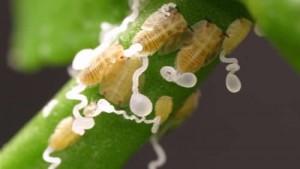
California farmers find themselves in a pitched battle against a little insect with a taste for citrus. The Asian citrus psyllid is having such a grand 'ole time sucking juice from plants across Southern California, it's moving north into the state's agriculture heartland. This week, a quarantine goes into effect in Tulare County, where state agriculture officials recently identified the third psyllid found in the county this year.
Entomologist Mark Hoddle of UC Riverside told the California Report it's not so much the wee psyllid that worries farmers as a bacterial disease that often travels inside the bug: huanlongbing (also known as "citrus greening").
The Asian citrus psyllid essentially acts "like a flying syringe," Hoddle says. It injects bacteria into each citrus tree it feeds on. "Once infected, there is no cure. It is a 5-8 year death sentence for the tree!" The disease has hit Florida citrus production hard since its discovery there in 2005.
Despite efforts to get the word out to citizens with citrus trees in their backyards, Californians can unwittingly move trees and fruit from infested to un-infested areas. That, and there are so many citrus trees in California backyards, it's easy for the psyllid to hopscotch from one property to another. "As you can imagine," Hoddle says, "it's very difficult to police."
Farmers have been applying topical pesticides to protect against infestation. They also wash fruit ahead of shipping it to market, so it's not something consumers have to worry about - yet.